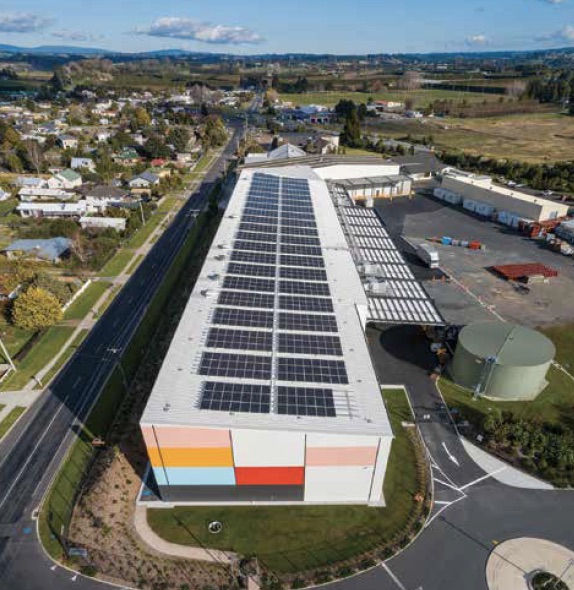Natural health food company Comvita’s new warehouse in Paengaroa features the Bay of Plenty’s largest solar panel installation, enabling the building to generate enough energy to power 53 New Zealand households.
For Comvita, sustainability was a key part of its new premises, as a reflection of the company’s products — natural health products made from sustainably sourced raw materials — and its philosophy of helping people to be well and connected with nature.
The purpose-built 3500sq m East Wing warehouse on the company’s seven-hectare site was sustainably designed by Jigsaw Architects in Tauranga, and sits alongside its existing head office and tourism venture, Experience Comvita.
Within this $11.7 million building is storage space for the company’s natural health products, a new honey sampling room, and covered outdoor work areas for loading and unloading trucks.
Chief executive Scott Coulter says the company now has a purpose-built and sustainably-designed warehouse to store its world-renowned honeys, and to support global logistics.
Sustainable features include the Bay of Plenty’s largest solar panel installation, enabling the building to generate enough energy to power 53 New Zealand households.
The temperature control system in the building uses cool, night-time air during the summer months to maintain a desirable temperature. Fitted through the premises are LED lights that should reduce onsite energy consumption by 25,000kW annually.
Additionally, more than 65% of construction waste from the project has been recycled. Waste water is treated onsite using environmentally-friendly practices, and is used to irrigate a community garden that is open to local residents, and supports 40,000 native and bee-friendly plants.
Local construction company Marra built the warehouse, and civil and drainage work was carried out by Higgins.
Central to the design of the new warehouse is the roof and wall cladding, which uses Kingspan panel systems. The construction schedule required that the roof and external walls were erected first.
The enclosed environment meant that the concrete could be poured and finished to achieve a very flat floor surface. This enabled the high-reach turret trucks to work in the narrow aisle racking configuration.
Brad Harkin of Harkin Roofing, whose company supplied and installed the 3600sq m roof, as well as external and internal wall cladding, says the roof design was straightforward, apart from the fact that Kingspan insulated panels (KS 1000 RW) were specified rather than a more traditional material like long-run steel.
However, there was a valid reason for this decision. Using insulated panels for the walls and roof of the warehouse ensures the temperature inside the building can be maintained at a constant, warm level, important when the product being stored is honey.
Each Kingspan panel measures 11m long by 1m wide with a 100mm core thickness, and weighs 120kg.
“These large insulated panels are installed in quite a different way to a traditional iron roof, and the impact on the interior of the building is obviously very different too. With these panels, it is possible to maintain a constant temperature inside the building, whereas corrugated iron cools down at night and heats up during the day.
“Kingspan has a high R value so it stays at a constant temperature,” Mr Harkin says.
Installing such large and heavy panels added complexity to the project. Harkin Roofing used a new system to them to get the panels from the ground to the roof without damaging them.
“All the panels were installed with an 80-tonne crane and a cladboy — a suction-lifting device that is charged up overnight and is attached to the crane.
“Each panel can be lifted into place so there was no manual handling of the panels. Then a couple of guys on the roof screw each one into place.
“At 120kg, there is a real risk of damage to the panels if they are being moved around, so using the crane and cladboy substantially reduced this risk,” he says.
“This technique added some cost and a bit more logistics to managing the project. We needed to keep a close track of how many panels were installed each day to ensure we were keeping on schedule and didn’t need the crane on site for any longer than necessary.”
But, on the other hand, this technique reduces the number of roofers required to work on the roof.
Mr Harkin says the Comvita warehouse was the first job where they have used the cladboy, and it was so successful the company has bought a second one.
Even though installing insulated panels such as these required fewer roofers to be on the job than with a standard roof, temporary safety nets were slung around under the eaves and edge protection was installed to ensure a safe working environment.
• Story adapted from article printed in Rooflink, the official magazine of RANZ.




